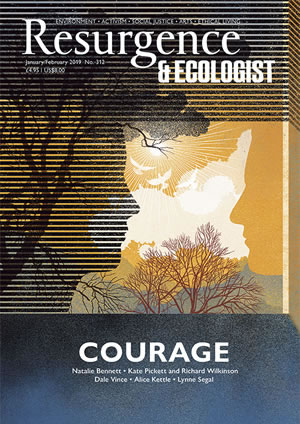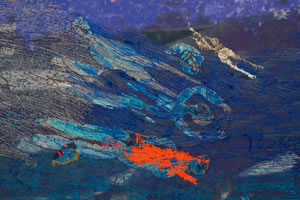Textiles connect people. They are part of our everyday lives. They are also part of a journey and become threadbare. This leads to the idea of ‘bearing witness’, recognising the importance of stories of migration and allowing those stories to be told. Of course, textiles themselves migrate, through historical trade routes. These threads have been exported and imported, these patterns are in our everyday lives. The title of our project Thread Bearing Witness is about the connecting thread of people.
The project includes three key pieces, ‘GROUND’, ‘SEA’ and ‘SKY’. They have a human scale, so you feel within them. ‘GROUND’ and ‘SKY’ are informed by refugees’ contributions of imagery and textile cultural heritage for a collective common ground of making. ‘SEA’ is the only one made by me alone. It emerged from the saturation of media imagery from that period of time in 2016. Everyone remembers those incredible images coming through the media daily of the horror of people in the sea.
The three pieces reflect my increasing involvement with individuals. I had to start making ‘SEA’ before I met any of the refugees. They took part in the project through ‘GROUND’ and ‘SKY’. This was because the pieces take a huge amount of time to make and I had to begin. So there were practical considerations to take into account, but in a way I think that’s quite interesting, since the project is about learning through the voices of others, changing perspectives and representing those who contribute as truly as I could. The works open a space for others to enter and participate within.
My daughter, Tamsin Koumis, introduced me directly to the experience of refugee issues. She has a background of working with migrants and refugees and set up the Dunkirk Legal Support Team, which enabled access to human rights at the refugee camp in France. Her organisation has connections to various individuals who have come to this country. I met up with them and carefully discussed how they might want to contribute to the project. It was very much led by them. I started meeting up with a group of Syrian women in my home town and continue to meet them weekly. I’ve become very close to them. I did some training with a refugee support group, Southampton & Winchester Visitors Group, since I was very aware that I needed to understand safeguarding and delicate, sensitive issues of trauma and culture.
There is no blueprint for how people have been participating. I’ve had to recognise we’ve got to treat each contribution very differently and to be open and led by each participant. One contributor is Saamiullah Khan, an unaccompanied minor from Kandahar, Afghanistan, who was in the Dunkirk camp and eventually came to the UK thanks to the Dunkirk Legal Support Team and others. He had to leave Afghanistan because of the Taliban. His mother and sisters are still there. His father died in the UK. Saami is an extraordinary young man. He is truly gifted, and has a great sense of responsibility for his family, whom he is missing terribly. We did various activities together. He wanted to design a piece of work and asked his family in Kandahar to stitch it into a beautiful cloth with the Afghan map at the centre. With Tamsin he wrote about Afghan embroidery. His circumstances were very compromised and difficult and we’ve now lost touch with him. So it’s been heart-rending.
I went with Tamsin to PIKPA refugee camp in Lesvos, Greece. That was very different. We made different things every day, building up trust with the residents. I now send out art and sewing materials, wool and crochet hooks so that the camp can continue making. Much of the project exists outside what is actually represented in the exhibition, and I feel that’s really important.
We wanted to include those who just wanted to be part of the project but aren’t refugees themselves. So we devised the Stitch a Tree project, inspired by the work of Refugee Resilience Collective, a group of narrative psychologists and psychotherapists working in the Calais camp. They held drawing workshops with children and used the tree of life as a narrative therapy tool, describing it as a symbol of strength, life and nourishment. For the Stitch a Tree project, we invited people to contribute stitched trees. These form a collective forest, which reflects the idea that we are all individuals but we come together as a shared world. We expected 200 to 300 contributions, but there are now about 5,000. We have had trees sent to us from groups of schoolchildren who have never stitched before, and beautiful exquisite contributions from experts. It’s multicultural, cross-generational and across genders. This has been a really extraordinary wave of human support, and it is still growing – it’s almost unstoppable.
Meeting with refugees has made me constantly reflect back on my own privilege. It can be very troubling to feel a helplessness to make change. Equally, we feel inspired by people who are living through traumatic circumstances. We are constantly asking ourselves if what we are doing is actually helping. This notion of bearing witness and authenticity has been hard to negotiate and is very sensitive. I’m not an expert in migration. I’m just an artist. I can’t resolve these issues, but I can show that I care.
Textiles is a medium that has a really powerful presence. It’s a unique kind of activism holding sensitivities and nuances of soft voices that can be repressed and hidden, yet vocalised through this medium. These are the voices that can bear witness to all of those individuals who might not have a voice elsewhere.
Thread Bearing Witness is at the Whitworth Gallery at the University of Manchester until 24 February 2019. www.threadbearingwitness.com








